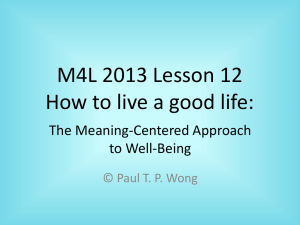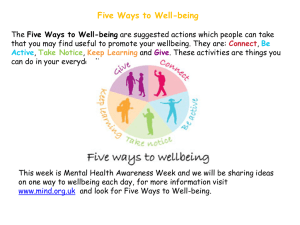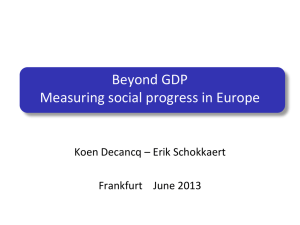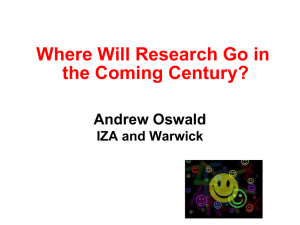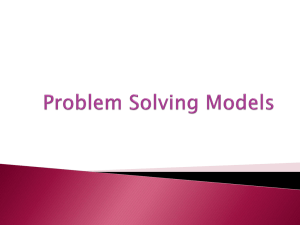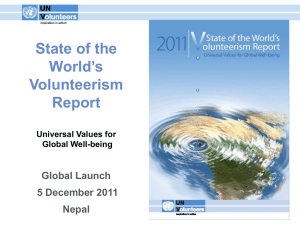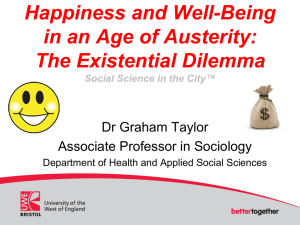module #4: national pursuits of happiness
advertisement
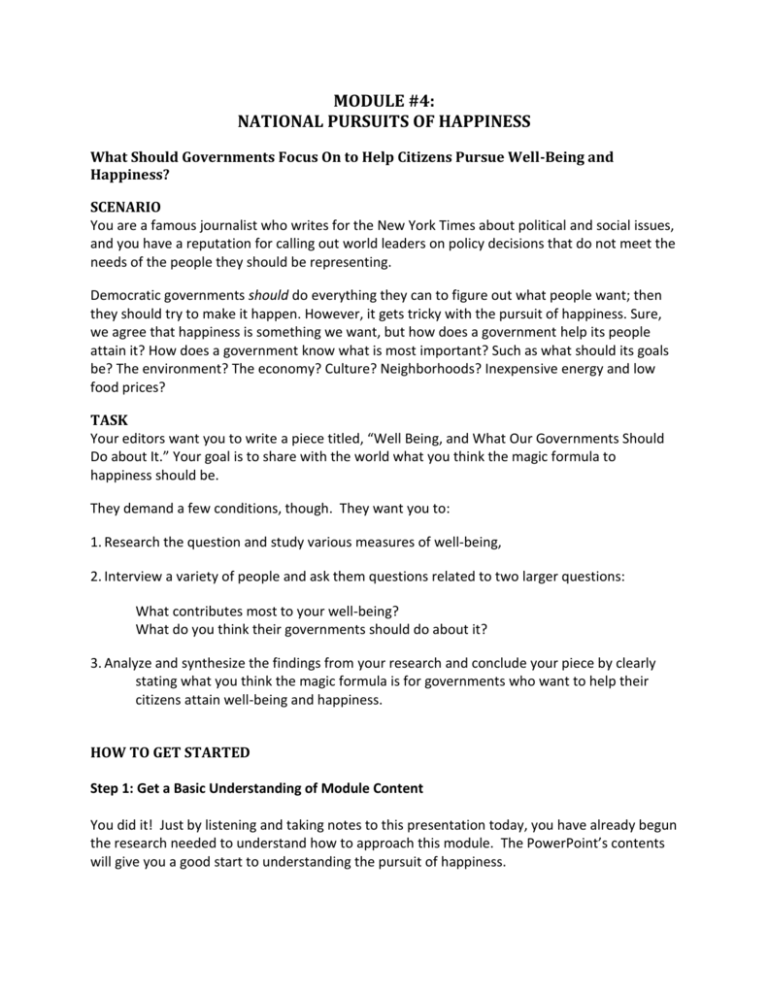
MODULE #4: NATIONAL PURSUITS OF HAPPINESS What Should Governments Focus On to Help Citizens Pursue Well-Being and Happiness? SCENARIO You are a famous journalist who writes for the New York Times about political and social issues, and you have a reputation for calling out world leaders on policy decisions that do not meet the needs of the people they should be representing. Democratic governments should do everything they can to figure out what people want; then they should try to make it happen. However, it gets tricky with the pursuit of happiness. Sure, we agree that happiness is something we want, but how does a government help its people attain it? How does a government know what is most important? Such as what should its goals be? The environment? The economy? Culture? Neighborhoods? Inexpensive energy and low food prices? TASK Your editors want you to write a piece titled, “Well Being, and What Our Governments Should Do about It.” Your goal is to share with the world what you think the magic formula to happiness should be. They demand a few conditions, though. They want you to: 1. Research the question and study various measures of well-being, 2. Interview a variety of people and ask them questions related to two larger questions: What contributes most to your well-being? What do you think their governments should do about it? 3. Analyze and synthesize the findings from your research and conclude your piece by clearly stating what you think the magic formula is for governments who want to help their citizens attain well-being and happiness. HOW TO GET STARTED Step 1: Get a Basic Understanding of Module Content You did it! Just by listening and taking notes to this presentation today, you have already begun the research needed to understand how to approach this module. The PowerPoint’s contents will give you a good start to understanding the pursuit of happiness. Step 2: Fieldwork When the discussion of fieldwork comes up with your editor, you mention that when you were in school you participated in a simulation called the Civic Mirror. Fascinated, he says, “Listen, I want you to conduct two surveys, asking the same questions. In the first, survey roughly 5 of your old Civic Mirror classmates (which, of course, you will do now). In the second, survey at least 5 people from at least 5 demographic groups. For each survey, make sure you do not interview more than 20 people. Got it?” He outlines the demographic groups as follows: - At least one person is under 18 years of age At least 3 people are between 19 to 65 years of age At least one person is over 65+ years of age Please ensure that your respondents are not from the same household Please ensure that all of your respondents have different occupations. You can choose to collect this data on a survey program (for example, Google forms or http:// www.surveymonkey.com), or collect data in paper format. Finally, and to keep things consistent, you are to use a series of questions already prepared for you below. Step 3: Analyze and Report Your Conclusions Analysis: Please gather information from your interviewees and analyze their responses as to what contributes to their well-being. Do you see any trends develop (for example do a lot of people believe the same things are important in the pursuit of happiness)? Are there any consistencies that can help you draw some conclusions? Please refer to the rubric. Reporting Your Conclusions: Once you gather all the data from your interviewees and analyze the information by grouping the responses to each question, you will probably notice some trends. Use what you learn in this module and the trends you discover in your surveys to write a magic formula for national pursuits of well-being. Include in your magic formula everything that is needed to create well-being for the citizens of your country. Highlight specifically the most important factors that contribute to well-being. FORMAT Your finished product can be done in the following ways: 1. Report format ~ typed and printed, Microsoft Word, Google Docs, and similar. 2. Slide-show presentation ~ Prezi, iMovie, PowerPoint, and similar. 3. Video format ~ YouTube, Vimeo, and similar. Regardless of format, remember you will be evaluated on your ability to meet all the expectations in the evaluation. EVALUATION Your presentation needs to show that you: 1. Conducted the required fieldwork using Appendix A – do not create your own questions! 2. Analyzed the responses and found (or attempted to find) trends in the survey responses, 3. Arrived at a conclusion about what “magic formula” governments should use to help their citizens best pursue happiness and well-being, ensuring that your conclusion is based on the content in this learning and the findings from your survey, and 4. Synthesized everything above and put it into a good presentation using one of the formats listed above. Be sure to select the presentation format that best fits your style, and make sure your presentation format does not make it difficult to communicate what you want to communicate. Before you get started, you should look at the evaluation rubric below to review what is expected of you on this project. The silliest thing you could do would be to work hard on the wrong stuff. No one in the real world is promoted that way! Appendix A - Interview Questions Interviewee: ________________________ Age: _____ Occupation:______________ Interview Part One: Question Overall, the economy is the most important thing in for a country’s wellbeing. Thriving businesses are the most important factor to a nation’s well- being. Having a nice home is a key ingredient to a person’s well-being and happiness. Having lots of money is the most important thing for an individual’s wellbeing. Problems occur when some people are dramatically richer than others. Energy should be a priority for a government because it spurs development of all kinds. There is an economic cost to resource depletion. Overall, the environment is the most important thing in for a country’s wellbeing. Clean air and atmosphere are important factors that are necessary for a country’s well-being. Clean water and arable land are important factors that are necessary for a country’s well-being. Strongly Agree Somewhat Agree Somewhat Disagree Strongly Disagree Do Not Know Question Sustainable development and renewable energy are important factors that are necessary for a country’s wellbeing. Rights and Freedoms (such as mobility, speech, and religion) are the most important factor to an individual’s wellbeing. Safety and Security are important for human beings to achieve well- being and happiness. Health is the most important factor to an individual’s well-being. Education is the most important factor to an individual’s well-being. There are economic and social costs of decreased levels of education. Life Balance is important for human beings to achieve well-being and happiness. Community and Culture are important for human beings to achieve well-being and happiness. Strongly Agree Somewhat Agree Somewhat Disagree Strongly Disagree Do Not Know Interviewees: From Civic Mirror Nation Name /Pseudonym Name /Pseudonym 1. 6. 2. 7. 3. 8. 4. 9. 5. 10. From My Real World Community Name /Pseudonym 1. 2. 3. 4. 5. 6. 7. 8. 9. 10. Age Occupation household Module #3 - National Pursuit of Well-Being Rubric Criteria 3 Field Work * Asked prepared questions to at least 5 participants from different demographic groups for Step #1. * Asked prepared questions to 5 game participants after 2 simulated years (Step #2). * A strong analysis is developed. * Graphical data is synthesized and displayed in clear visual/pictorial format Analysis * Summarizes and shows insightful synthesis of the responses. * Analysis includes responses of well-being from all interviewees 2 * Poses prepared questions to at least 4 participants from different demographic groups for Step #1 * Poses prepared questions to Civic Mirror participants (ideally after 2 simulated years). * Analysis is reasonably well developed. 1 * Poses prepared questions to less than 4 participants: there was overlap of demographic groups. * Poses prepared questions to game participants (Step #2). * Analysis is not well developed. * Attempts made to synthesize graphical data. * No visuals of graphic Visual format may be data. lacking or confusing * Summarizes the overall information obtained by interviewees. * Analysis includes responses of well-being from most (10+) interviewees * Summary lacks synthesis of the responses. * Analysis includes responses from 3 or fewer interviewees * Analysis drives the conclusion. * Conclusion is consistent, thorough and answers question Conclusion * A magic formula for happiness and well-being is suggested. * Most important factors that contribute to wellbeing are clearly emphasized in the magic formula. * Conclusion answers the research questions. Presentation * Sentence structure is consistently clear and lucid with virtually no spelling or grammatical errors. * Format of presentation selected (report, slideshow, video, etc.) enhances the audience’s understanding of the magic formula; selected format is unique and engages the audience. Teacher Comments: * Analysis does drive the conclusion to some extent. * There are some connections between conclusions reached and research questions asked. * Analysis does not drive the conclusion. * Poor connection between conclusions reached and research questions asked. * A magic formula for happiness and well-being is suggested. * Unable to suggest a magic formula for happiness and wellbeing. * Attempts to emphasize important factors, but may stray from topic. * Does not include or emphasize important factors * Presentation is for the most part clearly worded and unambiguous. * Sentence structure is mostly clear with minor spelling or grammatical errors. * Format of the presentation selected is relevant to the information provided; selected format informs the audience. * Throughout the presentation, wording is imprecise or ambiguous. * Sentence structure is consistently weak. * Format of presentation selected is not a good fit, or is not well executed; format does not engage nor inform audience.

